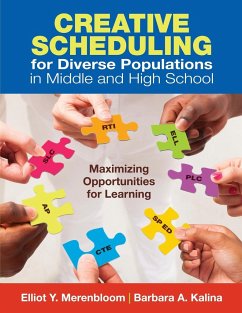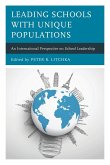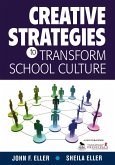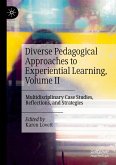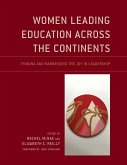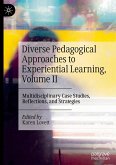Elliot Y. Merenbloom, Barbara A. Kalina
Creative Scheduling for Diverse Populations in Middle and High School
Maximizing Opportunities for Learning
Elliot Y. Merenbloom, Barbara A. Kalina
Creative Scheduling for Diverse Populations in Middle and High School
Maximizing Opportunities for Learning
- Broschiertes Buch
- Merkliste
- Auf die Merkliste
- Bewerten Bewerten
- Teilen
- Produkt teilen
- Produkterinnerung
- Produkterinnerung
Diverse needs, streamlined schedule-find out how with this all-in-one resource! How can each school day be inclusive for all learners, while making the most of limited time and resources? Help has arrived with th
Andere Kunden interessierten sich auch für
![Leading Schools with Unique Populations Leading Schools with Unique Populations]() Leading Schools with Unique Populations63,99 €
Leading Schools with Unique Populations63,99 €![Leading Schools with Unique Populations Leading Schools with Unique Populations]() Leading Schools with Unique Populations35,99 €
Leading Schools with Unique Populations35,99 €![Creative Strategies to Transform School Culture Creative Strategies to Transform School Culture]() John EllerCreative Strategies to Transform School Culture35,99 €
John EllerCreative Strategies to Transform School Culture35,99 €![Diverse Pedagogical Approaches to Experiential Learning, Volume II Diverse Pedagogical Approaches to Experiential Learning, Volume II]() Diverse Pedagogical Approaches to Experiential Learning, Volume II119,99 €
Diverse Pedagogical Approaches to Experiential Learning, Volume II119,99 €![Women Leading Education Across the Continents Women Leading Education Across the Continents]() Women Leading Education Across the Continents126,99 €
Women Leading Education Across the Continents126,99 €![Women Leading Education Across the Continents Women Leading Education Across the Continents]() Women Leading Education Across the Continents35,99 €
Women Leading Education Across the Continents35,99 €![Diverse Pedagogical Approaches to Experiential Learning, Volume II Diverse Pedagogical Approaches to Experiential Learning, Volume II]() Diverse Pedagogical Approaches to Experiential Learning, Volume II119,99 €
Diverse Pedagogical Approaches to Experiential Learning, Volume II119,99 €-
-
-
Diverse needs, streamlined schedule-find out how with this all-in-one resource! How can each school day be inclusive for all learners, while making the most of limited time and resources? Help has arrived with th
Produktdetails
- Produktdetails
- Verlag: Corwin
- Seitenzahl: 232
- Erscheinungstermin: 2. November 2012
- Englisch
- Abmessung: 280mm x 216mm x 13mm
- Gewicht: 595g
- ISBN-13: 9781412995252
- ISBN-10: 1412995256
- Artikelnr.: 36132205
- Herstellerkennzeichnung
- Libri GmbH
- Europaallee 1
- 36244 Bad Hersfeld
- gpsr@libri.de
- Verlag: Corwin
- Seitenzahl: 232
- Erscheinungstermin: 2. November 2012
- Englisch
- Abmessung: 280mm x 216mm x 13mm
- Gewicht: 595g
- ISBN-13: 9781412995252
- ISBN-10: 1412995256
- Artikelnr.: 36132205
- Herstellerkennzeichnung
- Libri GmbH
- Europaallee 1
- 36244 Bad Hersfeld
- gpsr@libri.de
List of Figures
List of Tables
Acknowledgments
About the Authors
Introduction
1. Schedules: The Springboard for Action
Mission/Vision
Catalyst for Change
Using the Schedule Effectively
Flexibility
Role of the Scheduling Committee
Teacher Contracts
Programs for Diverse Populations
2. Special Programs for Educational Success: RTI, Special Education, and
ELL
Response to Intervention
Special Education
English-Language Learner Programs
3. Special Programs for Educational Success: Credit Recovery, Career and
Technical Education, Gifted and Talented, Advanced Placement, and
International Baccalaureate
Credit Recovery
Career and Technical Education
Honors, Gifted and Talented, Advanced Placement, and International
Baccalaureate
4. Inclusive Scheduling Frameworks: Fixed
Semester 1/Semester 2
Double English/Double Mathematics
Quarters
Day 1/Day 2
Trimesters
Credit Recovery
Rotational
Single Subject
Traditional
Special Populations and Fixed Schedule Matrix
5. Inclusive Scheduling Frameworks: Variable
Interdisciplinary - Maximum Flexibility
Interdisciplinary - Limited Flexibility
Interdisciplinary - Encore/Exploratory
Combination
6. Integrating Fixed and Variable Frameworks Into a Comprehensive Schedule
Interchangeability: Fixed to Fixed
Interchangeability: Fixed to Variable
7. Learning Communities and Flexibility
Flexibility Strategies
8. Steps in Building a Middle School Schedule
Step 1: Connect With the Mission/Vision Statement
Step 2: Choose Structural Frameworks
Step 3: Create Bell and Lunch Schedules
Step 4: Formulate Program of Studies
Step 5: Project Enrollment
Step 6: Decide Team Composition
Step 7: Develop a Blueprint
Step 8: Assemble Grid of Teachers¿ Assignments
Step 9: Plan Professional Development
9. Steps in Building a High School Schedule
Step 1: Connect With the Mission/Vision Statement
Step 2: Choose Structural Frameworks
Step 3: Create Bell and Lunch Schedules
Step 4: Formulate Program of Studies
Step 5: Develop Student Registration Materials
Step 6: Establish Student Database
Step 7: Project Enrollment
Step 8: Decide Composition of Houses, Magnets, or Academies
Step 9: Create Department Summaries
Step 10: Distribute Available FTEs
Step 11: Categorize Teacher Assignments
Step 12: Develop a Blueprint for Small Learning Communities
Step 13: List Singletons, Doubletons, and Tripletons
Step 14: Formulate Conflict Matrix for Singletons, Doubletons, and
Tripletons
Step 15: Place Singletons, Doubletons, and Tripletons on Master Schedule by
Teacher and by Period
Step 16: Enter Remainder of Courses
Step 17: Initial and Subsequent Computer Runs
Step 18: Implement Professional Development
10. Using the Schedule for Effective Instruction
A Brief History of Instructional Influence
Pacing the Curriculum
Lesson Plan Foundations: Conceptual Lens, Target Learning, and Essential
Questions
The Lesson Plan and Learning Engagements
11. Professional Development to Support the Comprehensive Schedule
Enacting Change
Mission/Vision Statements
Principal Leadership
Requisites for Professional Learning
Instruction Within the Schedule
Appendix
References
Index
List of Tables
Acknowledgments
About the Authors
Introduction
1. Schedules: The Springboard for Action
Mission/Vision
Catalyst for Change
Using the Schedule Effectively
Flexibility
Role of the Scheduling Committee
Teacher Contracts
Programs for Diverse Populations
2. Special Programs for Educational Success: RTI, Special Education, and
ELL
Response to Intervention
Special Education
English-Language Learner Programs
3. Special Programs for Educational Success: Credit Recovery, Career and
Technical Education, Gifted and Talented, Advanced Placement, and
International Baccalaureate
Credit Recovery
Career and Technical Education
Honors, Gifted and Talented, Advanced Placement, and International
Baccalaureate
4. Inclusive Scheduling Frameworks: Fixed
Semester 1/Semester 2
Double English/Double Mathematics
Quarters
Day 1/Day 2
Trimesters
Credit Recovery
Rotational
Single Subject
Traditional
Special Populations and Fixed Schedule Matrix
5. Inclusive Scheduling Frameworks: Variable
Interdisciplinary - Maximum Flexibility
Interdisciplinary - Limited Flexibility
Interdisciplinary - Encore/Exploratory
Combination
6. Integrating Fixed and Variable Frameworks Into a Comprehensive Schedule
Interchangeability: Fixed to Fixed
Interchangeability: Fixed to Variable
7. Learning Communities and Flexibility
Flexibility Strategies
8. Steps in Building a Middle School Schedule
Step 1: Connect With the Mission/Vision Statement
Step 2: Choose Structural Frameworks
Step 3: Create Bell and Lunch Schedules
Step 4: Formulate Program of Studies
Step 5: Project Enrollment
Step 6: Decide Team Composition
Step 7: Develop a Blueprint
Step 8: Assemble Grid of Teachers¿ Assignments
Step 9: Plan Professional Development
9. Steps in Building a High School Schedule
Step 1: Connect With the Mission/Vision Statement
Step 2: Choose Structural Frameworks
Step 3: Create Bell and Lunch Schedules
Step 4: Formulate Program of Studies
Step 5: Develop Student Registration Materials
Step 6: Establish Student Database
Step 7: Project Enrollment
Step 8: Decide Composition of Houses, Magnets, or Academies
Step 9: Create Department Summaries
Step 10: Distribute Available FTEs
Step 11: Categorize Teacher Assignments
Step 12: Develop a Blueprint for Small Learning Communities
Step 13: List Singletons, Doubletons, and Tripletons
Step 14: Formulate Conflict Matrix for Singletons, Doubletons, and
Tripletons
Step 15: Place Singletons, Doubletons, and Tripletons on Master Schedule by
Teacher and by Period
Step 16: Enter Remainder of Courses
Step 17: Initial and Subsequent Computer Runs
Step 18: Implement Professional Development
10. Using the Schedule for Effective Instruction
A Brief History of Instructional Influence
Pacing the Curriculum
Lesson Plan Foundations: Conceptual Lens, Target Learning, and Essential
Questions
The Lesson Plan and Learning Engagements
11. Professional Development to Support the Comprehensive Schedule
Enacting Change
Mission/Vision Statements
Principal Leadership
Requisites for Professional Learning
Instruction Within the Schedule
Appendix
References
Index
List of Figures
List of Tables
Acknowledgments
About the Authors
Introduction
1. Schedules: The Springboard for Action
Mission/Vision
Catalyst for Change
Using the Schedule Effectively
Flexibility
Role of the Scheduling Committee
Teacher Contracts
Programs for Diverse Populations
2. Special Programs for Educational Success: RTI, Special Education, and
ELL
Response to Intervention
Special Education
English-Language Learner Programs
3. Special Programs for Educational Success: Credit Recovery, Career and
Technical Education, Gifted and Talented, Advanced Placement, and
International Baccalaureate
Credit Recovery
Career and Technical Education
Honors, Gifted and Talented, Advanced Placement, and International
Baccalaureate
4. Inclusive Scheduling Frameworks: Fixed
Semester 1/Semester 2
Double English/Double Mathematics
Quarters
Day 1/Day 2
Trimesters
Credit Recovery
Rotational
Single Subject
Traditional
Special Populations and Fixed Schedule Matrix
5. Inclusive Scheduling Frameworks: Variable
Interdisciplinary - Maximum Flexibility
Interdisciplinary - Limited Flexibility
Interdisciplinary - Encore/Exploratory
Combination
6. Integrating Fixed and Variable Frameworks Into a Comprehensive Schedule
Interchangeability: Fixed to Fixed
Interchangeability: Fixed to Variable
7. Learning Communities and Flexibility
Flexibility Strategies
8. Steps in Building a Middle School Schedule
Step 1: Connect With the Mission/Vision Statement
Step 2: Choose Structural Frameworks
Step 3: Create Bell and Lunch Schedules
Step 4: Formulate Program of Studies
Step 5: Project Enrollment
Step 6: Decide Team Composition
Step 7: Develop a Blueprint
Step 8: Assemble Grid of Teachers¿ Assignments
Step 9: Plan Professional Development
9. Steps in Building a High School Schedule
Step 1: Connect With the Mission/Vision Statement
Step 2: Choose Structural Frameworks
Step 3: Create Bell and Lunch Schedules
Step 4: Formulate Program of Studies
Step 5: Develop Student Registration Materials
Step 6: Establish Student Database
Step 7: Project Enrollment
Step 8: Decide Composition of Houses, Magnets, or Academies
Step 9: Create Department Summaries
Step 10: Distribute Available FTEs
Step 11: Categorize Teacher Assignments
Step 12: Develop a Blueprint for Small Learning Communities
Step 13: List Singletons, Doubletons, and Tripletons
Step 14: Formulate Conflict Matrix for Singletons, Doubletons, and
Tripletons
Step 15: Place Singletons, Doubletons, and Tripletons on Master Schedule by
Teacher and by Period
Step 16: Enter Remainder of Courses
Step 17: Initial and Subsequent Computer Runs
Step 18: Implement Professional Development
10. Using the Schedule for Effective Instruction
A Brief History of Instructional Influence
Pacing the Curriculum
Lesson Plan Foundations: Conceptual Lens, Target Learning, and Essential
Questions
The Lesson Plan and Learning Engagements
11. Professional Development to Support the Comprehensive Schedule
Enacting Change
Mission/Vision Statements
Principal Leadership
Requisites for Professional Learning
Instruction Within the Schedule
Appendix
References
Index
List of Tables
Acknowledgments
About the Authors
Introduction
1. Schedules: The Springboard for Action
Mission/Vision
Catalyst for Change
Using the Schedule Effectively
Flexibility
Role of the Scheduling Committee
Teacher Contracts
Programs for Diverse Populations
2. Special Programs for Educational Success: RTI, Special Education, and
ELL
Response to Intervention
Special Education
English-Language Learner Programs
3. Special Programs for Educational Success: Credit Recovery, Career and
Technical Education, Gifted and Talented, Advanced Placement, and
International Baccalaureate
Credit Recovery
Career and Technical Education
Honors, Gifted and Talented, Advanced Placement, and International
Baccalaureate
4. Inclusive Scheduling Frameworks: Fixed
Semester 1/Semester 2
Double English/Double Mathematics
Quarters
Day 1/Day 2
Trimesters
Credit Recovery
Rotational
Single Subject
Traditional
Special Populations and Fixed Schedule Matrix
5. Inclusive Scheduling Frameworks: Variable
Interdisciplinary - Maximum Flexibility
Interdisciplinary - Limited Flexibility
Interdisciplinary - Encore/Exploratory
Combination
6. Integrating Fixed and Variable Frameworks Into a Comprehensive Schedule
Interchangeability: Fixed to Fixed
Interchangeability: Fixed to Variable
7. Learning Communities and Flexibility
Flexibility Strategies
8. Steps in Building a Middle School Schedule
Step 1: Connect With the Mission/Vision Statement
Step 2: Choose Structural Frameworks
Step 3: Create Bell and Lunch Schedules
Step 4: Formulate Program of Studies
Step 5: Project Enrollment
Step 6: Decide Team Composition
Step 7: Develop a Blueprint
Step 8: Assemble Grid of Teachers¿ Assignments
Step 9: Plan Professional Development
9. Steps in Building a High School Schedule
Step 1: Connect With the Mission/Vision Statement
Step 2: Choose Structural Frameworks
Step 3: Create Bell and Lunch Schedules
Step 4: Formulate Program of Studies
Step 5: Develop Student Registration Materials
Step 6: Establish Student Database
Step 7: Project Enrollment
Step 8: Decide Composition of Houses, Magnets, or Academies
Step 9: Create Department Summaries
Step 10: Distribute Available FTEs
Step 11: Categorize Teacher Assignments
Step 12: Develop a Blueprint for Small Learning Communities
Step 13: List Singletons, Doubletons, and Tripletons
Step 14: Formulate Conflict Matrix for Singletons, Doubletons, and
Tripletons
Step 15: Place Singletons, Doubletons, and Tripletons on Master Schedule by
Teacher and by Period
Step 16: Enter Remainder of Courses
Step 17: Initial and Subsequent Computer Runs
Step 18: Implement Professional Development
10. Using the Schedule for Effective Instruction
A Brief History of Instructional Influence
Pacing the Curriculum
Lesson Plan Foundations: Conceptual Lens, Target Learning, and Essential
Questions
The Lesson Plan and Learning Engagements
11. Professional Development to Support the Comprehensive Schedule
Enacting Change
Mission/Vision Statements
Principal Leadership
Requisites for Professional Learning
Instruction Within the Schedule
Appendix
References
Index

